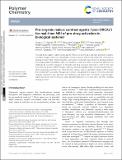| dc.contributor.author | Nguyen, Hung VanThanh | |
| dc.contributor.author | Detappe, Alexandre | |
| dc.contributor.author | Harvey, Peter | |
| dc.contributor.author | Gallagher, Nolan | |
| dc.contributor.author | Mathieu, Clelia | |
| dc.contributor.author | Agius, Michael P. | |
| dc.contributor.author | Zavidij, Oksana | |
| dc.contributor.author | Wang, Wencong | |
| dc.contributor.author | Jiang, Yivan | |
| dc.contributor.author | Rajca, Andrzej | |
| dc.contributor.author | Jasanoff, Alan Pradip | |
| dc.contributor.author | Ghobrial, Irene M. | |
| dc.contributor.author | Ghoroghchian, Paiman Peter | |
| dc.contributor.author | Johnson, Jeremiah A. | |
| dc.date.accessioned | 2020-07-14T20:57:47Z | |
| dc.date.available | 2020-07-14T20:57:47Z | |
| dc.date.issued | 2020-06 | |
| dc.date.submitted | 2020-04 | |
| dc.identifier.issn | 1759-9954 | |
| dc.identifier.issn | 1759-9962 | |
| dc.identifier.uri | https://hdl.handle.net/1721.1/126188 | |
| dc.description.abstract | Nitroxide-based organic-radical contrast agents (ORCAs) are promising as safe next-generation magnetic resonance imaging (MRI) tools. Nevertheless, stimuli-responsive ORCAs that enable MRI monitoring of prodrug activation have not been reported; such systems could open new avenues for prodrug validation and image-guided drug delivery. Here, we introduce a novel “pro-ORCA” concept that addresses this challenge. By covalent conjugation of nitroxides and drug molecules (doxorubicin, DOX) to the same brush-arm star polymer (BASP) through chemically identical cleavable linkers, we demonstrate that pro-ORCA and prodrug activation, i.e., ORCA and DOX release, leads to significant changes in MRI contrast that correlate with cytotoxicity. This approach is shown to be general for a range of commonly used linker cleavage mechanisms (e.g., photolysis and hydrolysis) and release rates. Pro-ORCAs could find applications as research tools or clinically viable “reporter theranostics” for in vitro and in vivo MRI-correlated prodrug activation. | en_US |
| dc.description.sponsorship | National Cancer Institute (Grant P30-CA14051) | en_US |
| dc.publisher | Royal Society of Chemistry (RSC) | en_US |
| dc.relation.isversionof | http://dx.doi.org/10.1039/d0py00558d | en_US |
| dc.rights | Creative Commons Attribution 4.0 International license | en_US |
| dc.rights.uri | https://creativecommons.org/licenses/by/4.0/ | en_US |
| dc.source | Royal Society of Chemistry (RSC) | en_US |
| dc.title | Pro-organic radical contrast agents (“pro-ORCAs”) for real-time MRI of pro-drug activation in biological systems | en_US |
| dc.type | Article | en_US |
| dc.identifier.citation | Nguyen, Hung V.-T. et al. "Pro-organic radical contrast agents (“pro-ORCAs”) for real-time MRI of pro-drug activation in biological systems." Forthcoming in Polymer Chemistry 2020 (June 2020) © 2020 The Royal Society of Chemistry | en_US |
| dc.contributor.department | Massachusetts Institute of Technology. Department of Chemistry | en_US |
| dc.contributor.department | Massachusetts Institute of Technology. Department of Biological Engineering | en_US |
| dc.contributor.department | Massachusetts Institute of Technology. Department of Brain and Cognitive Sciences | en_US |
| dc.contributor.department | Massachusetts Institute of Technology. Department of Nuclear Science and Engineering | en_US |
| dc.contributor.department | Koch Institute for Integrative Cancer Research at MIT | en_US |
| dc.relation.journal | Polymer Chemistry | en_US |
| dc.eprint.version | Final published version | en_US |
| dc.type.uri | http://purl.org/eprint/type/JournalArticle | en_US |
| eprint.status | http://purl.org/eprint/status/PeerReviewed | en_US |
| dspace.date.submission | 2020-07-10T14:46:32Z | |
| mit.journal.volume | 2020 | en_US |
| mit.license | PUBLISHER_CC | |
| mit.metadata.status | Complete | |
